| Dark Sky South Australia |
|
The Science Astronomy Links Contact |
|
Examples of Good and Bad Lighting Practices in Adelaide Adelaide like most
cities around the world has a range of good, bad and
everything-in-between outdoor lighting. While street
lighting has gradually improved due to evolving
Australian Standards most commercial lighting is
left to "self-regulation" and is rarely monitored.
This allows buyers to fall for cheap and
inefficient lighting fixtures that are often mounted
and aimed without consideration for the amenity of
the district. Glary lighting does not necessarily
increase safety and can create a motoring hazard,
disturbing sleep and in some cases can actually increase
criminal activity. Bad lighting wastes light thereby
wastes energy adding unnecessary atmospheric
emissions and costs more in the long term. Good
lights control the beam and are aimed at the target
area. This improves general night time visibility
and safety and promotes amenity, and in the long
term saves energy and money. |
|
Roadway lighting
Over the
years roadway lighting has evolved with HPS (high
pressure sodium lamps) illuminating the majority of
highway lighting. The orange glow is due to sodium and
is chosen for its better efficiency compared to most
other high luminosity lighting. You may see them in
various types of luminaire housings that resemble a
"cobra head". There are two main varieties, semi-cutoff
and full-cuttoff.
Note: Luminaire is the light fitting that contains the lamp, its housing and electronics but not the pole and rigging. Roadway lighting is covered by the Australian Standard AS1158 |
|
Fair
While the refractor bowl on this semi-cutoff
HPS lamp was designed for wide road coverage it still
emits glary sidelight that dazzles motorists. [West
Lakes Blvd].
|
Good
Full-cutoff
HPS lamps replaced with a flat plate that emits all light downward creating
a well illuminated and minimum-glare roadway. Often
known as aeroshields to avoid any
uplight confusing pilots, they are seen in other
suburbs due to their low-glare factor. [Sir Donald Bradman
Drive]
|
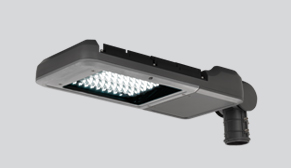 |
LED
Lighting (Light Emitting
Diode)
The nighttime lighting situation is
rapidly changing with the introduction
of new technology LED illumination in
recent years. It promises better beam
control and colour temperature choice
with computer control for dimming at
curfew hours with significant energy
savings. LED lighting is now replacing
the older luminaires in street
lighting, advertising, car parks,
business premises, security etc,
but
almost none of the LED lighting
installed up to date has any of
the promising controls implemented.
While local Councils tend to be more
conscientious, businesses and private
users often install LEDs with the same lack of due
care as with previous older lights
resulting in even more over lighting
more glare and more light trespass.
Adoption of LEDs with their higher
intensity and blue-white colour means
sky glow is expected to increase
exponentially, diminishing the starry
sky over cities faster than ever! (More
to come on LEDs).
|
|
Residential streetlights
They come in a range of species
from bad to fair. The worst are the "flowerpot" mercury
vapour lamps that have almost no beam control. They are
gradually being phased out in favour of Metal halide
(white) and a lower wattage version of the highway
HPS lighitng. |
|
Bad
This
outdated "no-cutoff" and inefficient 80 watt
"flower-pot" mercury street lamp emits considerable
amount of side-light and up-light creating a harsh glare
adding to sky glow. They still pervade many residential
streets in Adelaide |
Better
This
more efficient semi-cutoff 50 watt HPS
street lamp is a better choice though some light still
escapes uselessly sideways and forward creating glare. |
|
Business
and "Security" Lighting
This lighting
varies more than any other kind. There is everything
from extremely bad lighting to to very good lighting.
The Australian Standard AS4282-1997
The Control of the
Obtrusive Effects of Outdoor Lighting
has been in existence since 1997. The Standard
outlines recommendations for correct choice, fitting
and aiming outdoor lights to minimise the obtrusive
effects of glare, light trespass and sky glow on
residents, natural preserves and observatories. Yet it
never seems to be enforced. Local Councils tend to be
lax or apathetic in dealing with widespread
overstepping of the standard throughout Australia!
|
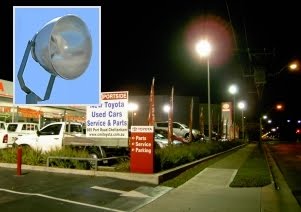 |
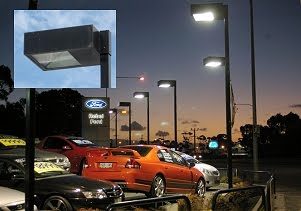 |
|
Bad
Cheap, inefficient and glary metal halide lights
in a Cheltenham car yard. These lights are aimed
almost horizontally spilling light upwards and and
dazzling motorists on Port Road. |
Good
Pooraka car yard uses quality full cut-off box
lights that reduce glare and up-light. Creates a
visually ambient environment that enhances the look of
the sales stock. |
Bad Typical configuration of lumniaires found at commercial car yards, sports grounds and warehouse security. Only the lower portion of the beam reaches the yard while the remainder (about 40%) escapes sideways and upward adding to glare, light trespass and sky glow, running costs as well as emissions from wasted energy. |
|
Bad
Left: This unshielded flood
light at a corner car sales yard emits glarey light
far beyond the confines of the business premises,
wasting light and...Right: forcing residents
across the road to install heavy duty window shutters.
This kind of light pollution detracts from amenity and
can easily be remedied with a quality full-cutoff
floods and after-hours curfew.
|
|
Bad
This
double-fluoro luminaire at a Port Adelaide
warehouse has no shielding. Most of the
light beams wastefully sideways and upward! |
Good
By
contrast this Wingfield warehouse has
installed a full cut-off luminaire that
directs almost all of its light
usefully downward to the property. |
|
Very
Bad!
No consideration was given to the aiming of this
full-cutoff, forward-throw
flood light mounted over a car park at Transport SA
Port Adelaide. The light is incorrectly aimed so that
and most of the light is wastefully beamed into
the sky! |
Good
Here is the correct positioning of forward-throw
floods at Glenelg Oval car park. They are mounted
horizontally as prescribed to throw light forward and
downward. |
|
Bad
Unshielded
post-top lanterns kill off old style charm emitting
glarey sidelight and over-lighting at Port Adelaide. |
Good
Shielded walkway lanterns at Semaphore foreshore
avoid glare and keeps light levels to amenable levels
while preserving utility. |
|
Bad
|
more Bad
|
|
Bad
The light patterns on the wall reveal how these
"Yarra Post-top" walkway lanterns allow considerable
light to wastefully escape sideways and upwards. Location: Mawson Lakes. |
Good
|
|
Bad
Billboard
illuminated from below loses light skyward wasting
energy creating glare to passing motorists and adding to
sky-glow. |
Better
Down-lights
illuminate sign from above reducing uplight and glare |
|
Sports Lighting Night
time sports ground illumination is covered by Australian Standard
2560.
|
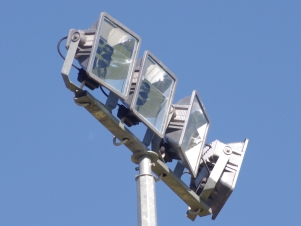 |
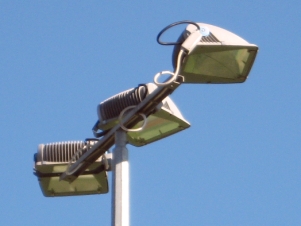 |
|
Bad
|
Good
Largs
Oval (Largs Bay) is fitted with full cut-off
floods confining light to the sports ground
minimising glare and light trespass in the
surrounding residential area. |
| Next -
Useful links |